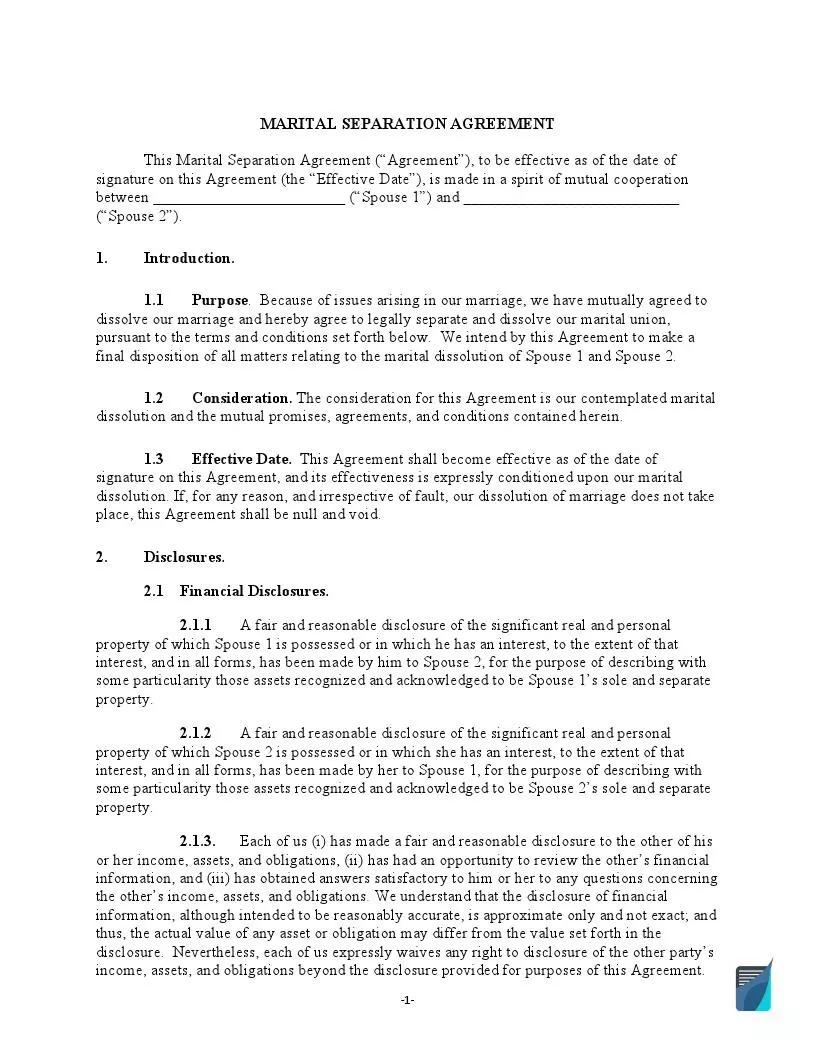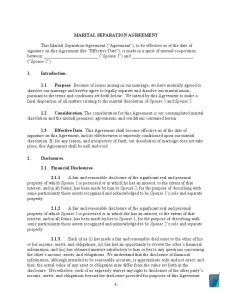Divorce Settlement Agreement Template
A divorce settlement agreement, also known as a marital settlement agreement, is a legally-binding document between separating spouses that arranges and settles issues connected with divorce. These issues include division of property and financial assets, child custody and support, visitation rights, and spousal support. A marital settlement agreement is a good way to make divorce less hurtful for both spouses.
When preparing a divorce settlement agreement, you have to be careful and attentive. Our divorce settlement agreement template, along with the step-by-step guidelines, will help you not to miss any important details during the document’s preparation. However, you are encouraged to address a family law attorney, who will consult you and correct the agreement if necessary.

Build Your Document
Answer a few simple questions to make your document in minutes
Save and Print
Save progress and finish on any device, download and print anytime
Sign and Use
Your valid, lawyer-approved document is ready
Why Use a Marital Settlement Agreement
Divorce is always a time and effort-consuming process. Moreover, it’s emotionally exhausting for both separating spouses. A divorce settlement agreement makes the process of divorcing easier and helps to avoid the following problems:
- If a divorcing couple does not use a divorce agreement, it’s up to the judge to decide how the assets and liabilities will be divided or how many children and spousal support will be paid. With the agreement, you can avoid such court involvement in the process.
- The spouses may end up arguing about each term of the agreement and spending a lot of time on the litigation process. The agreement saves your time and lessens the stress connected with legal proceedings.
- If you decide to file for divorce, you may have to pay a huge amount of legal fees and attorneys’ costs. If you conclude a divorce agreement, you can avoid all the emotional and economic turmoil.
It’s highly recommended that each spouse has an individual lawyer for the process. Even if one spouse prepares the agreement, the other must look through it with the attorney. If you don’t involve your lawyer, you may end up missing some important provisions related to your interests. If another spouse does not have an attorney, they can later claim that the agreement is not fair.
How to Prepare for a Divorce Settlement
Before writing a marital settlement agreement, you need to negotiate the terms with your future x-spouse. Very often, the relationships between divorcing spouses are hard to call civil. In this case, you need to find a lawyer to represent you and keep in touch with the other spouse. If you agree to conclude a marital settlement agreement, you should start the negotiation process with the next steps.
Step 1. Consult your attorney

First, you are recommended to consult a divorce attorney on the best arrangements. The attorney can help to define the most suitable provisions. If you have the agreement ready, your attorney can review the document and correct the mistakes if necessary. If you don’t have a divorce attorney, you can request your friends’ help or look into the online platforms, for example, Avvo or LegalMatch.
Step 2. Communicate with your spouse

After drafting the agreement’s terms with your attorney, you should communicate with your spouse and send him or her your draft of the agreement. Later on, it’s necessary to arrange the meeting, considering that your spouse needs to review the agreement and add what they want to get after the divorce.
Step 3. Meet and negotiate the provisions

The next step is to meet with the other spouse and negotiate the agreement’s provisions. Make sure that both parties fully disclose all information about the assets and debts. It’s crucial for outlining child and spousal support. It would be best if you negotiated the provisions, keeping your emotions in check. Sometimes, the parties agree on certain provisions, for example, child custody or alimony, but cannot agree on others. If it happens, it’s possible to make a partial divorce settlement or discuss the other terms with the help of a mediator.
Step 4. Sign the agreement

When you both finally come up with an agreement, you should carefully recheck the document and correct any mistakes and errors. Then, both spouses should sign the agreement and notarize the signatures (optionally but recommended).
Step 5. Go to court

After the marital settlement is agreed upon, it must be approved by the judge. If the agreement is prepared thoroughly, it should not take much time. The judge only reviews the agreement and decides whether it’s fair for both separating spouses. If not, the judge will request you to revise the agreement and develop more reasonable provisions.
Step 6. Receive a divorce decree

If every agreement’s provision is reasonably justified, the judge will approve it and you will get a divorce decree, also known as a divorce judgment, which is the final and enforceable order you must follow. The process is usually going faster with a divorce settlement agreement, and the parties are officially divorced within 30-60 days after finishing the divorce case.
What Information a Divorce Agreement Should Cover
A divorce settlement agreement helps to avoid exhausting disputes in the event of separation. If you want to sign a divorce agreement but cannot agree upon its provisions, you should hire a family law attorney to help you out. If you and your spouse can negotiate all the necessary terms, you can try to outline them together. In any case, you have to consider the following information in your agreement.
Property and assets division
The document should contain information on dividing all properties, assets, and debts after the marriage dissolution. It’s necessary to add as many details as possible and consider all the disclosed data: real estate, credit card accounts, personal possessions, and retirement benefits. Without these terms, your property is at risk of being divided not exactly as you want to. There are community property states that provide an equal (50/50) division of all marital property. These states include California, Arizona, Nevada, Louisiana, Idaho, New Mexico, Washington, Texas, Wisconsin. The rest of the states have equitable-distribution laws, where the court divides the assets fairly, considering such factors as income of each of the spouses, prenuptial and postnuptial agreements, spousal support, and alimony obligations. The divorce settlement agreement allows you to distinguish between separate and community property and divide the assets due to your needs.
Child custody and support
If you have minor children, then you should provide child custody and support provisions. In some cases, both parents may share physical and legal custody. In other cases, children may spend most of the time with one parent and sometimes visiting the other parent; it’s called primary physical custody. There is also sole custody, where one parent has the right and responsibility to make main decisions connected with the child’s welfare. For primary or sole custody, you have to include the parenting time and visitation provisions. It’s also important to indicate that neither parent may change a minor child’s place without prior written notice to the other parent. As for child support, it depends on different factors, including the earning powers of both parents, healthcare, or extracurricular expenses. The parents may agree on the amount to be paid. However, even with a divorce settlement agreement, the judge may change the legal arrangements for a child’s best interest.
Alimony and spousal maintenance
In this section, you need to provide information related to the amount of alimony and spousal maintenance. You should identify how much will be paid, to whom, and for how long. It’s relevant for the spouse, who during the marriage gives up the career for the family and spends the time raising children or helping the other spouse with the career. In the event of a divorce, it’s crucial to define the amount of support this spouse will have to get back on track. If there is no alimony to be paid, spouses should state that they waive it.
Divorce Laws by State
| STATES | Waiting periods for divorce | FILING FEE | STATE LAW |
| Alabama | At least 30 days | Varies by county ($200-300) | Alabama Code, Section 30-2-1 to 30-2-12 |
| Alaska | 30-90 days | $250 | Alaska Statutes, Chapter 25.24 |
| Arizona | 90-120 days | Approximately $234 (varies by county) | Arizona Revised Statutes, Title 25, Chapter 3 mostly |
| Arkansas | 3 months (or around 30 days if spouses have been separated for 12 months) | Approximately $165 (varies by county) | Arkansas Annotated Code, Title 9, Subtitle 2, Chapter 12 |
| California | At least 6 months | $435 | California Family Code, Division 6, Sections 2000-2452 |
| Colorado | 6-9 months | $230 | Colorado Revised Statutes, Title 14, Article 10 |
| Connecticut | 30-90 days | $350 + $50 fee for having the court papers served + $125 for mandatory parenting education class (if spouses have children) | Connecticut Revised Statutes, Chapter 815j |
| Delaware | 30-90 days | $165 or more (depending on a case) | Delaware Code, Title 13, Chapter 15 |
| Florida | Around 3 months | Around 400$ (varies by county) | Florida Statutes, Title VI, Chapter 61 |
| Georgia | 45-60 days | Around $200 to $220 | Georgia Code, Title 19, Chapter 5 |
| Hawaii | 30-90 days | $215 (no children) or $265 (with children) | Hawaii Revised Statutes, Title 31, Sections 580-41 to 580-56 mostly |
| Idaho | 30-90 days | $207 | Idaho Statutes, Title 32 |
| Illinois | Around 90 days | Varies by county ($289 in average) | Illinois Compiled Statutes, Chapter 750, Section 5/ |
| Indiana | 60 days | Depending on the court ($177 in average) | Indiana Code, Section 31-15 |
| Iowa | At least 90 days | $265 | Iowa Code, Chapter 598 |
| Kansas | At least 60 days | $100 to $200 (varies by county) | Kansas Statute, Chapter 23, Articles 27-30 mostly |
| Kentucky | At least 60 days | $113 (but may vary by county) | Kentucky Revised Statutes, Chapter 403 |
| Louisiana | At least 30 days | At least $150-250 | Louisiana Revised Statutes, Sec. 9:301 to 9:375; Civil Code, Art. 102, 103, 103.1, 111, 112, and 113; and Code of Civil Procedure, Art. 10 and 3941 |
| Maine | At least 60 days | $120 | Maine Revised Statutes, Title 19-A, Chapters 29 and 63 |
| Maryland | At least 60 days | $165 (self-represented) or $185 (with attorney) | Maryland Annotated Code, Family Law, Title 7, 11 and 12 |
| Massachusetts | At least 90 days | $215 | Massachusetts General Laws, Chapter 208 |
| Michigan | At least 60 days | $175 or $255 (with children) | Michigan Compiled Laws, Chapter 552 |
| Minnesota | At least 30 days | $365 (but may vary by county) | Minnesota Statutes, Chapter 518 |
| Mississippi | At least 60 days | At least $50 (varies by county) | Mississippi Annotated Code, Title 93, Chapters 5 and 27 |
| Missouri | At least 30 days | At least $150 | Missouri Revised Statutes, Chapter 452 |
| Montana | At least 20 days | $200 | Montana Annotated Code, Title 40, Chapter 4 |
| Nebraska | At least 60 days | $158 | Nebraska Revised Statutes, Chapter 42; Supreme Court Rules, Chapter 4, Article 2 |
| Nevada | At least one (1) week | At least $200 (varies by county) | Nevada Revised Statutes, Title 11, Chapter 125 |
| New Hampshire | 2-8 weeks | $250 | New Hampshire Revised Statutes, Title XLIII, Chapter 458 |
| New Jersey | 6-12 weeks | $300 + mandatory $25 fee to take a parent education class | New Jersey Statutes, Section 2A:34 |
| New Mexico | 30-90 days | $137 | New Mexico Annotated Statutes, Chapter 40, Article 4 |
| New York | 6-12 weeks | $210 + $125 for Note of Issue | New York Consolidated Laws, Domestic Relations Law, Articles 9-13 |
| North Carolina | Around 45 days | $225 + $30 to have Sheriff serve the defendant or $7 to serve the defendant by certified mail | North Carolina General Statutes, Chapter 50 |
| North Dakota | 30-90 days | $80 | North Dakota Century Code, Chapter 14-05 |
| Ohio | 1-3 months | $150-400 | Ohio Revised Code, Chapter 3105 |
| Oklahoma | 10 or 90 days | $180-265 (varies by county) | Oklahoma Statutes, Title 43 |
| Oregon | 2-6 weeks | $301 | Oregon Revised Statutes, Sections 107.005 to 107.452 |
| Pennsylvania | 3-6 months | Varies by county (around $125-300) | Pennsylvania Consolidated Statutes, Title 23, Chapters 33, 35, and 37 |
| Rhode Island | 90 days | Varies by county | Rhode Island General Laws, Chapter 15-5 |
| South Carolina | At least 1-2 months | $150 | South Carolina Code of Laws, Title 20, Chapter 3 |
| South Dakota | At least 60 days | $95 | South Dakota Codified Laws, Chapter 25-4 |
| Tennessee | At least 60 days (without children) or 90 days (with children) | Varies by county (around $200–400) | Tennessee Code Annotated, Title 36, Chapter 4 |
| Texas | At least 60 days | $150-335 (varies by county) | Texas Statutes, Family Code, Title 1, Subtitle C |
| Utah | At least 30 days | $325 | Utah Code, Title 30, Chapter 3 |
| Vermont | At least 6 months (if with minor children) or 6 weeks (without children); in both cases, 90 day nisi period applies following the final judgment | $295 (if filing without stipulation), $90 (if with stipulation and one party is a resident), or $180 (if with stipulation and neither party is a resident) | Vermont Statutes, Title 15, Chapter 11 |
| Virginia | At least 3 months | Around $86-91 (varies by county) | Virginia Code, Title 20, Chapter 6 |
| Washington | At least 90 days | Varies by County (around $300-$325) | Washington Revised Code, Chapter 26.09 |
| West Virginia | At least 20 days | $135 (but may vary by county) | West Virginia Code, Chapter 48 |
| Wisconsin | 120 days | Around $180-200 | Wisconsin Statutes and Annotations, Chapter 767, Subchapter 4 mostly |
| Wyoming | 30-90 days | Around $120 | Wyoming Statutes, Title 20, Chapter 2 |

Filling out a Divorce Settlement Agreement
After the negotiation and preparation stage, you could start the writing process. Our templates help you create all the necessary documents in no time. Please, follow the next steps while preparing the agreement. You are recommended to consult the attorney on the final draft.
Step 1. Make an introduction
At the beginning of the document, you should fill in the introductory provisions. Here, you describe the purpose of the agreement and indicate the mutual consent on the terms. It confirms that both of you agree on how the assets and obligations should be divided. In this section, you identify the parties to the agreement and name the children (if any). You also need to indicate the date and place of your marriage, as well as the date of your separation.
Step 2. Describe the property and assets division
You should identify the property, possessions, and debts owed by the couple and how you will divide these assets. Here, you need to add provisions about the separate and community property of husband and wife. Without these provisions, the court will divide all property according to state laws. Make sure that you fully disclose all information. If you hide important financial information, the court may invalidate the agreement later on.
Step 3. Define child custody and child support
In this section, you should define child support and custody. You have to choose the type of custody and include the parenting time and visitation provisions (especially for primary or sole custody). As for child support, it’s necessary to identify how much children will get and for how long. The agreement should also contain the maintenance of health insurance for children. Even if you plan detailed child custody and support, you should be ready for additional expenses because the judge may decide to change your legal arrangements and appoint a lawyer for a child’s best interest.
Step 4. Provide the alimony details
It’s necessary to define the amount of spousal support to pay, for how long, and under what conditions. For example, spousal maintenance may continue until the supported spouse remarries. The agreement should also contain the maintenance of health insurance for a supported spouse.
Step 5. Indicate the governing laws
The governing laws are important to mention in the agreement. It’s necessary to indicate the jurisdiction (state and county) where the divorce will occur. As mentioned above, some states have community property laws, which influence the assets’ division after the marriage dissolution.
Step 6. Sign the agreement
Each party should carefully read the document and make sure it’s free of mistakes. If the agreement contains many typos, it will look less serious and create misunderstanding in the future. You can have attorneys review the documents before you sign them and ensure that it’s fair for both parties. It would be better if a notary witnessed your signatures.
Step 7. Add exhibits to the agreement
You are recommended to add exhibits and documents containing all the financial information, debts (if any), bank accounts, and retirement benefits. Thus, you provide full disclosure of the assets and make it credible for the judge that the parties have fully exchanged incomes and expenses. Yes, the original document can be modified, with both parties agreeing on such modifications. But as a general rule, you can modify only the provisions related to child custody, child support, or alimony. The court does not usually accept the modifications in the division of the assets. Moreover, there must be significant changes in your life to justify these modifications. These changes may include a new job or dismissal that significantly influences one of the ex-spouse’s income; one ex-spouse is injured or seriously ill; one parent is arrested or needs to relocate. If the modification is justified, the ex-spouses should conclude a modification agreement consisting of all the agreed-upon changes. The modified divorce agreement should be put into effect by a new court order. It is highly recommended that the original agreement contain provisions of possibility to modify some issues. Yes, you do. If you decide not to file for divorce but settle everything together, it’s great, and you can prepare to sign the marital settlement agreement. However, you are required to submit the signed agreement to the court to ensure that its terms are fair for both parties. The court finalizes the divorce judgment and makes it a binding document; you cannot violate the order. Technically, you are not required to do it. You may find divorce forms and templates and create your document. However, it’s highly recommended that your lawyer or family attorney review, clarify, and legally ensure the agreement. Without the attorney, you will be at risk of missing important provisions. Moreover, the other party’s lawyer can create a document that is more advantageous for them. All in all, you can end up signing an agreement that you do not properly understand.
Frequently Asked Questions
Is It Possible to Modify a Marital Settlement Agreement?
Do We Have to Address the Court if We Have A Divorce Agreement?
Is It Necessary to Address the Attorney When Preparing a Divorce Agreement?